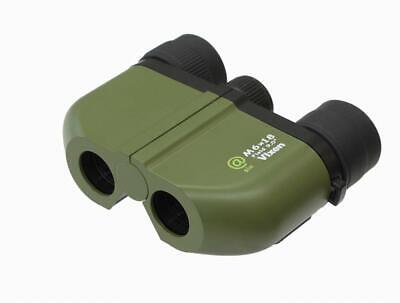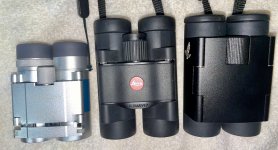I tend to like Vixen binoculars, they usually offer great value and pretty good optics. I guess it has to do with the decisions regarding the selection of products from different Asian producers, because it seems that they choose models also offered by other brands (like Opticron, Celestron, DDOptics, Kowa, etc.). So far I’ve had 9 Vixen binoculars and I think there has not been a single one that has disappointed me, with some models far exceeding my expectations or the level of performance its price might have anticipated, like the Ultima Porro range (JB 56), the Foresta Porro range (I’ve had both the 8x32 and 7x50 of both of these two ranges), the Artes J, or even the New Foresta 8x56 AK, which is seriously bright. Now enter the quirkiest of the lot: the @Six 6x18 Here's a link to its webpage: Vixen Binoculars @Six 6X18 | Vixen
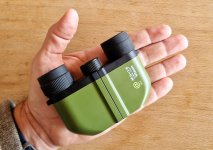
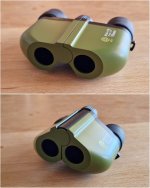
This is a truly pocket model that has many tricks up its sleeve. To begin with, it’s a true pocket binocular, at 145 g (5,1 oz), with a 3 mm EP, not 2,5 like other very small pockets, and this should offer a slightly higher level of comfort and ease of use. And now comes the amazing bit, this tiny toy-looking device features a 9º FOV… and a 55 cm close focus, like the Pentax Papilio… and this all comes in a colourful nifty bino costing 75 $ Is this all even possible? Let’s have a look.
Here, compared to the Nikon 8x25 Travelite EX (AKA Prostaff ATB) and the Nikon CF III 7x20 (my standard for pocket binos).
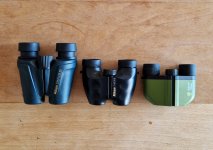
Design-wise, I think it’s rather catchy. I have a thing for quirky Japanese cars manufactured for their own market (JDM), like the Nissan Pao or Nissan Figaro. Well, while these Vixen won’t probably end up at the MOMA, I like the design work that has obviously been done on the hinge area, both when fully open or fully closed (when it reminds me of the kitten from the movie "Shrek").
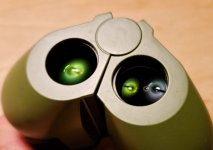

Eyecups are, as was to be expected, a little too narrow for my liking (inner diameter is around 27 mm, compared to 31 mm on the 7x20 Nikon CFIII, my standard pocket). But hey, this is a 145 g little binocular, so miniaturization had to take its toll somewhere. Anyway, the single hinge design kind of makes up for that in terms of usability. While in my experience 200 g is an absolute limit for a true pocket, I find sub-150 g ideal. This is the kind of object you can carry without noticing it. When I had the Ultravid 8x20, the 245 g really felt a little too much, also probably due to the fact that the leica feels "denser", while the 200 g Nikon 7x20 or this Vixen feel lighter than they are, probably because of their toy-like plasticky build.
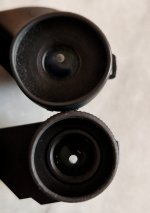
The image is surprisingly usable, more than reasonably sharp, it’s actually very pleasant. When scanning a landscape the image feels “nice”, which is quite a lot to say for such a diminute device: there’s no obvious flaw that might hinder the view. No terribly soft edges, no fussy areas, and you can get a sharp focus, unlike the Nikon 8x21 Aculon I tried a while ago, which was priced similarly but plagued by drawbacks. Compared to the Nikon CF III 7x20, the image feels “more contemporary”, in that there’s no yellow hue/tint, but a pretty accurate colour representantion, the white appears quite white, probably due to more modern coatings. If anything, I'd say colours err on the cold side of the colour spectrum.
While inspecting the Vixen I realised they use BK-7 glass, which I later on confirmed is indicated in the specs. You can notice the classical "diamond" shape when looking at the exit pupil.
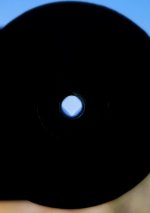
The figure given for FOV seems at least reasonable. Without a proper and accurate test, the 9º figure appears not to be too far off. Here it is compared with the 8,3º FOV of the Opticron Traveller ED 8x32. The image is noticeably wider. Aligned at the right edge with a flat building (a supermarket with green letters). On the left edge you can see how the Vixen offers a noticeably wider FOV, as a reference, on the lower left side of both images there is a white square (a small building), which is nearly at the field stop of the Opticron, but on the Vixen there is still a good deal of things to be seen before the field stop). Above, the 8,3º Opticron, below, the 9º Vixen.
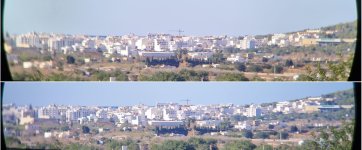
One thing that I’ve noticed is that the image feels a little “small”, I don’t know if this is due to the large FOV. Switching between the 7x20 Nikon and the 6x18 Vixen the difference feels larger than a 1x step. And then, comparing it to another 6x, the “cheap & cheerful” Kowa 6x30, the Kowa appears to display a larger image (again, this might be due to the narrower FOV of the Kowa). While switching between the Vixen and the Kowa you do notice a big jump in image quality, resolution, sharpness, 3D, pop… is like if someone had turned on the HD button. I wonder if this can be also due to the stereopsis on the Kowa. The image on the Vixen appears flat in comparison probably an outcome of comparing reverse against traditional Porro. But while I would say the “battle” between Vixen 6x18 and Nikon 7x20 was an even match between comparable forces, the Kowa 6x30 is simply on another level: well, it costs double the money and is also three times heavier and appears huge compared to the Vixen, and mind you, the Kowa is a very small and light binocular!
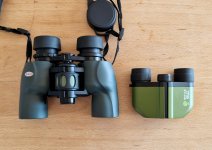
But now comes the amazing bit: the close focus is on Papilio territory. As a matter of fact, even though Vixen indicates 55 cm (21,6 inches), I can actually get a focus view from around 43 - 44 cm. However, that close the view is pretty annoying, since it’s nearly impossible to merge both images, even reducing IPD dramatically. So I guess the official figure is more or less true for a “usable” close focus… which is nothing short of amazing in my book.
The chapter of accessories is as small as the binocular, and also a little quirky: there are no caps whatsoever, and the bag is the kind that opens on the top, like roll-up watertight travel packs (or Ortlieb panniers), but it doesn't seem to roll. It is very lightly padded and comes with a cord that slides through one of those buckles used on guy lines of camping tents, a really minimal approach. The strap is also a little cord with the quick release buckle system I really like on binoculars. Anyway, given the nearly inexistent padding/protection, I guess a much more convenient solution is to simply carry the Vixen on a small sunglass fabric pouch.
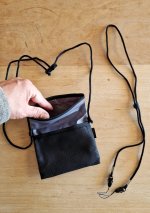
And finally, some cons and a small usability problem I've found. The focus wheel is of reasonable size for such a tiny bino. Smaller than the Nikon 7x20 (which is actually huge for that format), but it somehow protrudes backwards in a way that, at least for my facial features, makes me touch the tip of the focus wheel with my forehead right before my eyebrows touch the eyecups. In a way, is like if Vixen have inadvertendly invented the forehead rest Swarovsky has been championing over the last years!
 It's not terrible, but it makes focusing a little awkward. Talking about focusing, the focus wheel is OK, better than the Aculon 8x21, but offering a slightly different level of resistance across its very long throw, which turns for more than 2 complete turns. So, if you add to this the ability to focus from very close to very far, it means that there is quite a lot of turning to be made if you want to go from very close to infinity. On an "average" use however, the low magnification means very little focusing action is needed in practice.
It's not terrible, but it makes focusing a little awkward. Talking about focusing, the focus wheel is OK, better than the Aculon 8x21, but offering a slightly different level of resistance across its very long throw, which turns for more than 2 complete turns. So, if you add to this the ability to focus from very close to very far, it means that there is quite a lot of turning to be made if you want to go from very close to infinity. On an "average" use however, the low magnification means very little focusing action is needed in practice.
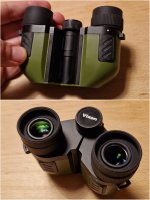
In summary. A true pocket binocular which is a midget on steroids: 6x, 9º FOV, 145 g and 50 cm close focus. An ideal companion to take anywhere: museum, concert, gallery, everyday, nature… So small and quite inexpensive too! No, don’t expect any miracle in terms of view, this offers no Leica Ultravid view, but don’t underestimate its abilities either. The image has no obvious flaws, which I find remarkable. So a very nice pocket to shortlist if you are looking for an EDC that can offer a lot for very little in a diminutive bino.


This is a truly pocket model that has many tricks up its sleeve. To begin with, it’s a true pocket binocular, at 145 g (5,1 oz), with a 3 mm EP, not 2,5 like other very small pockets, and this should offer a slightly higher level of comfort and ease of use. And now comes the amazing bit, this tiny toy-looking device features a 9º FOV… and a 55 cm close focus, like the Pentax Papilio… and this all comes in a colourful nifty bino costing 75 $ Is this all even possible? Let’s have a look.
Here, compared to the Nikon 8x25 Travelite EX (AKA Prostaff ATB) and the Nikon CF III 7x20 (my standard for pocket binos).

Design-wise, I think it’s rather catchy. I have a thing for quirky Japanese cars manufactured for their own market (JDM), like the Nissan Pao or Nissan Figaro. Well, while these Vixen won’t probably end up at the MOMA, I like the design work that has obviously been done on the hinge area, both when fully open or fully closed (when it reminds me of the kitten from the movie "Shrek").


Eyecups are, as was to be expected, a little too narrow for my liking (inner diameter is around 27 mm, compared to 31 mm on the 7x20 Nikon CFIII, my standard pocket). But hey, this is a 145 g little binocular, so miniaturization had to take its toll somewhere. Anyway, the single hinge design kind of makes up for that in terms of usability. While in my experience 200 g is an absolute limit for a true pocket, I find sub-150 g ideal. This is the kind of object you can carry without noticing it. When I had the Ultravid 8x20, the 245 g really felt a little too much, also probably due to the fact that the leica feels "denser", while the 200 g Nikon 7x20 or this Vixen feel lighter than they are, probably because of their toy-like plasticky build.

The image is surprisingly usable, more than reasonably sharp, it’s actually very pleasant. When scanning a landscape the image feels “nice”, which is quite a lot to say for such a diminute device: there’s no obvious flaw that might hinder the view. No terribly soft edges, no fussy areas, and you can get a sharp focus, unlike the Nikon 8x21 Aculon I tried a while ago, which was priced similarly but plagued by drawbacks. Compared to the Nikon CF III 7x20, the image feels “more contemporary”, in that there’s no yellow hue/tint, but a pretty accurate colour representantion, the white appears quite white, probably due to more modern coatings. If anything, I'd say colours err on the cold side of the colour spectrum.
While inspecting the Vixen I realised they use BK-7 glass, which I later on confirmed is indicated in the specs. You can notice the classical "diamond" shape when looking at the exit pupil.

The figure given for FOV seems at least reasonable. Without a proper and accurate test, the 9º figure appears not to be too far off. Here it is compared with the 8,3º FOV of the Opticron Traveller ED 8x32. The image is noticeably wider. Aligned at the right edge with a flat building (a supermarket with green letters). On the left edge you can see how the Vixen offers a noticeably wider FOV, as a reference, on the lower left side of both images there is a white square (a small building), which is nearly at the field stop of the Opticron, but on the Vixen there is still a good deal of things to be seen before the field stop). Above, the 8,3º Opticron, below, the 9º Vixen.

One thing that I’ve noticed is that the image feels a little “small”, I don’t know if this is due to the large FOV. Switching between the 7x20 Nikon and the 6x18 Vixen the difference feels larger than a 1x step. And then, comparing it to another 6x, the “cheap & cheerful” Kowa 6x30, the Kowa appears to display a larger image (again, this might be due to the narrower FOV of the Kowa). While switching between the Vixen and the Kowa you do notice a big jump in image quality, resolution, sharpness, 3D, pop… is like if someone had turned on the HD button. I wonder if this can be also due to the stereopsis on the Kowa. The image on the Vixen appears flat in comparison probably an outcome of comparing reverse against traditional Porro. But while I would say the “battle” between Vixen 6x18 and Nikon 7x20 was an even match between comparable forces, the Kowa 6x30 is simply on another level: well, it costs double the money and is also three times heavier and appears huge compared to the Vixen, and mind you, the Kowa is a very small and light binocular!

But now comes the amazing bit: the close focus is on Papilio territory. As a matter of fact, even though Vixen indicates 55 cm (21,6 inches), I can actually get a focus view from around 43 - 44 cm. However, that close the view is pretty annoying, since it’s nearly impossible to merge both images, even reducing IPD dramatically. So I guess the official figure is more or less true for a “usable” close focus… which is nothing short of amazing in my book.
The chapter of accessories is as small as the binocular, and also a little quirky: there are no caps whatsoever, and the bag is the kind that opens on the top, like roll-up watertight travel packs (or Ortlieb panniers), but it doesn't seem to roll. It is very lightly padded and comes with a cord that slides through one of those buckles used on guy lines of camping tents, a really minimal approach. The strap is also a little cord with the quick release buckle system I really like on binoculars. Anyway, given the nearly inexistent padding/protection, I guess a much more convenient solution is to simply carry the Vixen on a small sunglass fabric pouch.

And finally, some cons and a small usability problem I've found. The focus wheel is of reasonable size for such a tiny bino. Smaller than the Nikon 7x20 (which is actually huge for that format), but it somehow protrudes backwards in a way that, at least for my facial features, makes me touch the tip of the focus wheel with my forehead right before my eyebrows touch the eyecups. In a way, is like if Vixen have inadvertendly invented the forehead rest Swarovsky has been championing over the last years!

In summary. A true pocket binocular which is a midget on steroids: 6x, 9º FOV, 145 g and 50 cm close focus. An ideal companion to take anywhere: museum, concert, gallery, everyday, nature… So small and quite inexpensive too! No, don’t expect any miracle in terms of view, this offers no Leica Ultravid view, but don’t underestimate its abilities either. The image has no obvious flaws, which I find remarkable. So a very nice pocket to shortlist if you are looking for an EDC that can offer a lot for very little in a diminutive bino.
Last edited:





